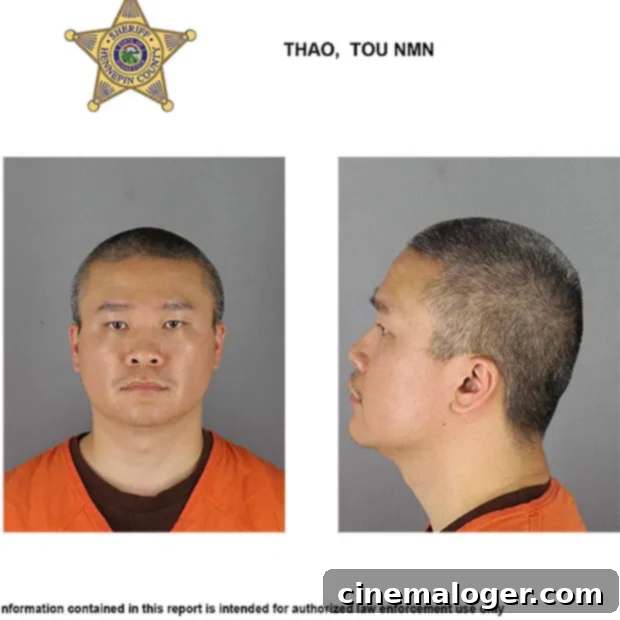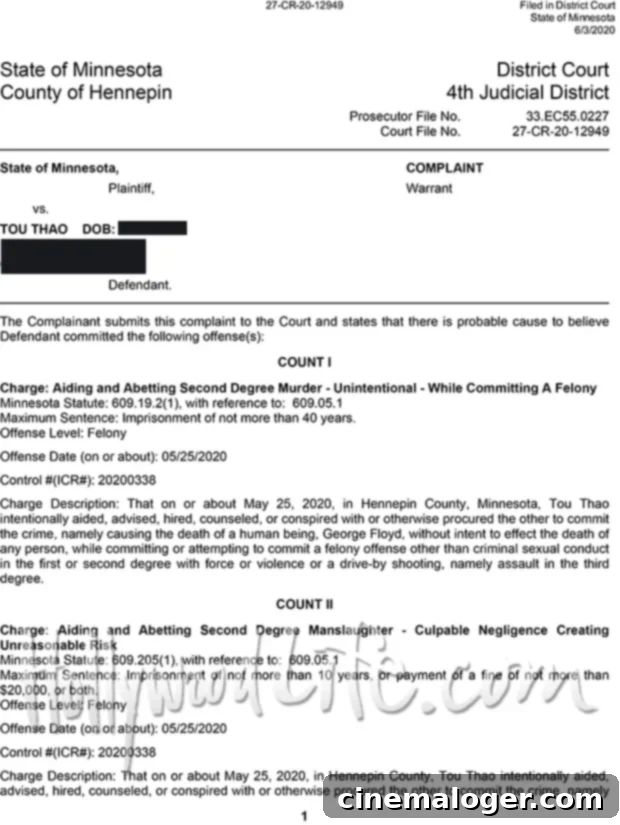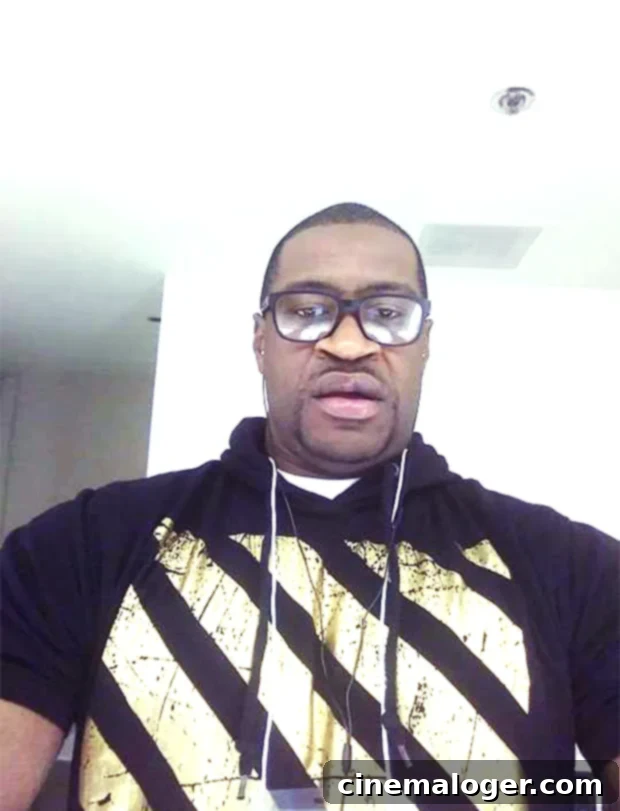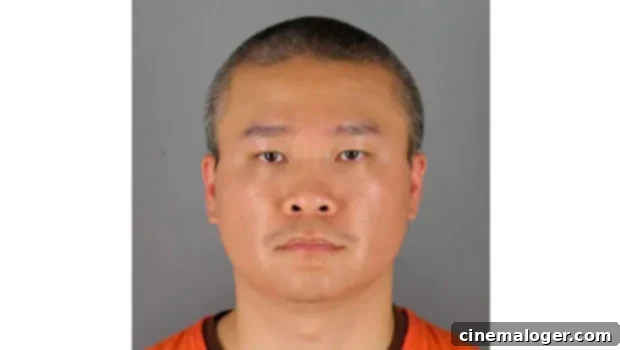Justice for George Floyd: Inside the Convictions of Officers Tou Thao, J. Alexander Kueng, and Thomas Lane for Civil Rights Violations
The tragic death of George Floyd on May 25, 2020, at the hands of Minneapolis police officer Derek Chauvin, sent shockwaves across the globe, sparking a powerful movement for racial justice and police accountability. The incident, captured on bystander video, showed Chauvin kneeling on Floyd’s neck for over nine minutes while Floyd pleaded for his life, ultimately resulting in his death. Alongside Chauvin, three other officers—Tou Thao, J. Alexander Kueng, and Thomas Lane—were present at the scene, their roles scrutinized by the public and legal system alike. These officers faced a barrage of charges, culminating in significant legal battles that underscored the complexities of police misconduct and the urgent need for reform.
In a crucial development on February 24, 2022, Tou Thao, along with J. Alexander Kueng and Thomas Lane, was convicted of violating George Floyd’s civil rights. This conviction stemmed from their collective failure to provide necessary medical attention to Floyd as Derek Chauvin maintained his fatal restraint. Both Thao and Kueng faced additional charges specifically for failing to intervene and prevent Chauvin from inflicting harm upon Floyd. These landmark convictions highlighted the legal responsibility of officers to protect individuals in their custody, even from the actions of fellow officers. The ramifications for Thao were particularly severe, as he could face up to 40 years in prison for aiding and abetting second-degree murder, a charge that was set for a separate trial commencing in June.
The public outrage and the subsequent legal proceedings swiftly catalyzed policy changes within the Minneapolis Police Department (MPD). Just two days after Thomas Lane, Tou Thao, and J. Alexander Kueng were charged with aiding and abetting second-degree murder and aiding and abetting second-degree manslaughter, a significant reform was enacted. The city of Minneapolis officially banned the use of chokeholds and neck restraints by its police force. This groundbreaking agreement, forged in collaboration with the Minnesota Department of Human Rights, implemented immediate and stringent new protocols. Under these new guidelines, any officer who witnesses or uses a neck restraint or chokehold is now mandated to report the incident without delay to their commanding officer or their commander’s superiors. This measure aimed to increase transparency and accountability, directly addressing the systemic issues brought to light by George Floyd’s death and preventing similar tragedies in the future.
Crucially, the new policy extended beyond mere reporting. It established a firm “duty to intervene” mandate, compelling officers to actively step in if they observe a colleague attempting to apply a chokehold or neck restraint on an individual. This intervention could be verbal, urging the colleague to cease the action, or escalate to physical intervention if deemed necessary to prevent harm. The consequences for failing to intervene were made severe, with officers facing potential punishments as stringent as those applied to the officer who committed the prohibited action, as reported by the Associated Press. Furthermore, to curb excessive force in other scenarios, the agreement stipulated that the use of potentially harmful crowd control or subduing tactics—including chemical agents, rubber bullets, flash-bang grenades, batons, and marking rounds—would now require explicit authorization from either the police chief or a deputy chief. These comprehensive reforms aimed to fundamentally alter policing practices in Minneapolis, emphasizing de-escalation, accountability, and the preservation of life.
The legal proceedings moved swiftly in the days following the initial charges. On June 4, 2020, during their first appearance in court, a judge set bail at a substantial $1,000,000 each for officers Tou Thao, Thomas Lane, and J. Alexander Kueng. This significant bail amount reflected the gravity of the charges against them—aiding and abetting second-degree murder and second-degree manslaughter—and the immense public interest and scrutiny surrounding the case. In stark contrast, Derek Chauvin, who faced even more severe direct charges of second-degree murder, third-degree murder, and manslaughter in George Floyd’s death, had his bail set at a comparatively lower $500,000. This disparity in bail amounts, while subject to various legal factors, sparked further discussions and questions about the legal system’s approach to the officers involved.
On June 3, 2020, the legal landscape surrounding George Floyd’s death expanded significantly with the charging of former Minneapolis Police Department officer Tou Thao for his direct role in the tragic incident. Thao, whose history included a prior police brutality complaint, was formally charged with aiding and abetting second-degree murder and aiding and abetting second-degree manslaughter. This development marked a pivotal moment, as initial expectations had largely focused on charges against only former officer Derek Chauvin. Chauvin, the officer notoriously seen kneeling on Floyd’s neck in the widely circulated video, had already been indicted with multiple counts, including second-degree murder, third-degree murder, and one charge of manslaughter. The decision to charge Thao, along with Lane and Kueng, signaled a broader legal interpretation of responsibility, recognizing that all officers present had a duty of care and intervention.
The formal announcement of these expanded charges came during a poignant press conference on June 3, led by Minnesota Attorney General Keith Ellison. His opening remarks immediately underscored the profound loss and injustice: “We’re here today because George Floyd is not here. He should be here. He should be alive but he’s not.” Ellison’s words resonated deeply with a public demanding accountability. He then detailed the legal actions taken, stating, “Today I filed an amended complaint that charges former Minneapolis police officer Derek Chauvin with murder in the second degree for the death of George Floyd. I believe the evidence available to us now supports the stronger charge of second degree murder.” This upgrade in charges against Chauvin reflected the escalating severity of the legal case. Ellison also outlined the significant penalties associated with these crimes, noting that aiding and abetting second-degree murder carries a potential sentence of up to 40 years in prison, while aiding and abetting manslaughter could lead to up to 10 years in prison. These legal pronouncements served as a crucial step towards affirming the severity of the officers’ actions and the commitment to pursuing justice through the full extent of the law.

Ellison continued, expanding on the legal net cast wider than just Derek Chauvin. “Second, today arrest warrants were issued for former Minneapolis police officers J. Alexander Kueng, Thomas Lane, and Tou Thao,” he announced, confirming that all officers present at the scene would face legal accountability. He further elaborated on the specific charges against them: “Finally, I’d like to announce that today Hennepin County Attorney Michael Freeman and I have filed a complaint that charges police officer Kueng, Lane, and Thao with aiding and abetting murder in the second degree, a felony offense.” This felony charge highlighted the severe legal implications of their alleged complicity in Floyd’s death. Ellison concluded his statement with a powerful affirmation of purpose: “I strongly believe that these developments are in the interests of justice for Mr. Floyd, his family, our community and our state.” His words resonated deeply, signaling a commitment from the state’s highest legal offices to pursue justice comprehensively, addressing not only the direct perpetrator but also those whose inaction contributed to the tragedy.
The brutal killing of George Floyd ignited an unprecedented wave of outrage and protests, not only across the United States but globally. Millions of people, from diverse backgrounds and geographies, demanded justice, calling for an end to systemic racism and police brutality that had long plagued communities of color. The images of Floyd’s final moments became a rallying cry, fostering a profound societal reckoning with issues of racial inequality and law enforcement accountability. As the world continued to grapple with these profound issues, and as legal proceedings unfolded for the four officers involved in Floyd’s death—Derek Chauvin, Tou Thao, Thomas Lane, and J. Alexander Kueng—public interest in understanding their individual roles and backgrounds intensified. Among these officers, Tou Thao’s presence at the scene and his subsequent charges made him a focal point of public scrutiny. Below, we delve deeper into the key aspects of former MPD officer Thao’s involvement and background.
1. Tou Thao Arrived on the Scene with Officer Derek Chauvin.
The sequence of events leading to George Floyd’s death began on May 25, 2020, when Minneapolis Police officers Thomas Lane and J. Alexander Kueng were the first to respond to a call from a clerk at the Cup Foods market. The clerk reported that a man, later identified as George Floyd, had allegedly purchased merchandise using a counterfeit $20 bill. This seemingly minor infraction quickly escalated. According to the criminal complaint meticulously filed by the Hennepin County Attorney, and detailed in documents obtained by HollywoodLife, Officers Lane and Kueng attempted to place Floyd in their squad car. During this struggle, they requested additional assistance. It was at this critical juncture, around 8:14 PM, that Officers Tou Thao and Derek Chauvin arrived on the scene as backup. Their arrival marked a significant turning point in the unfolding tragedy, bringing Chauvin, who would apply the fatal restraint, and Thao, who would control the gathered crowd, into the immediate vicinity of Floyd.

2. Tou Thao’s Role: Crowd Control and Failure to Intervene.
While officers Derek Chauvin, Thomas Lane, and J. Alexander Kueng were directly involved in the physical restraint of George Floyd, Tou Thao adopted a different, yet equally critical, role during the fatal encounter. Thao did not physically touch George Floyd or participate in his direct restraint. Instead, his primary action was to manage the growing number of concerned eyewitnesses who had gathered, alarmed by what they were seeing. In the widely circulated and harrowing viral video, Thao is distinctly seen instructing onlookers, often forcefully, to “get back on the sidewalk,” effectively creating a barrier between the public and the unfolding tragedy. This action, while seemingly a routine crowd control measure, became a crucial element in the legal charges against him. By actively preventing concerned citizens from getting closer or intervening, and by not intervening himself, Thao was accused of failing in his duty to protect Floyd. Meanwhile, the three other officers continued to press George Floyd down to the ground. The video vividly captured Chauvin kneeling across George’s neck, a position maintained despite Floyd’s increasingly desperate pleas for mercy and assertions that he couldn’t breathe. The severity of the situation escalated rapidly; approximately ten minutes after Chauvin and Thao’s arrival, around 8:24 PM, George Floyd tragically stopped moving, having lost consciousness and ultimately his life, all while Thao stood by, actively preventing others from helping or interfering.
3. Tou Thao Fled Minnesota Amid Public Outrage.
Tou Thao’s career path within the Minneapolis Police Department provided some insight into his background. According to the Star Tribune, he initially joined the MPD as a community service officer, a role focused on non-emergency public assistance and community engagement. He then successfully completed the police academy in 2009, transitioning into a sworn officer position. However, his tenure was not continuous; Thao experienced a two-year layoff period before returning to the department in 2012, eventually serving with Derek Chauvin in the same precinct. This background, while not uncommon, became subject to intense scrutiny in the wake of Floyd’s death.
The immediate aftermath of George Floyd’s death saw an outpouring of grief, anger, and a demand for justice that quickly escalated into widespread protests. As the viral video of the incident circulated globally, public fury intensified, particularly towards the officers involved. In response to this immense pressure and the credible threats of legal action and public condemnation, Tou Thao, like the other involved officers, found himself facing an unprecedented level of scrutiny and potential danger. His criminal defense attorney, Robert Paule, confirmed to the Star Tribune that the fired officer had, in fact, fled the state of Minnesota following the overwhelming outrage. His lawyer stated that Thao was “safely elsewhere,” indicating a conscious decision to remove himself from the immediate public eye and potential unrest in Minneapolis. This flight underscored the extreme pressure and volatile environment surrounding the case, as the officers became symbols of institutional failure and racial injustice.

4. Tou Thao’s History of Police Misconduct and Brutality.
The events surrounding George Floyd’s death were not the first time Tou Thao had faced accusations of excessive force or professional misconduct. A disturbing pattern emerged when reports highlighted his involvement in a 2017 police brutality lawsuit. According to the Star Tribune, Thao, alongside another unnamed officer, was implicated in a civil rights case filed by Lamar Ferguson. Ferguson alleged that in 2014, he was subjected to an unprovoked and brutal assault by two officers. He claimed they stopped him under the pretense of serving an arrest warrant, then proceeded to beat him while he was handcuffed, resulting in broken teeth and other injuries. The severity of these allegations led the city of Minneapolis to pay a substantial $25,000 to settle the civil rights case, indicating an acknowledgment of the merit of Ferguson’s claims. Ferguson himself recounted the terrifying experience to The Sun, stating, “They had no reason to stop me, they started asking me a whole bunch of questions, where I was going.” He specifically identified Thao as the primary aggressor: “[Thao] was the most aggressive one, I was in handcuffs within the first few minutes of the incident. I was horrified.” This prior incident painted a concerning picture of Thao’s temperament and policing methods, contributing to the broader narrative of systemic issues within the MPD.
Beyond the Lamar Ferguson lawsuit, Tou Thao’s service record further revealed a history of complaints. The Star Tribune also reported that Thao had accumulated “six unspecified police conduct complaints” against him during his tenure. While five of these complaints were “closed without discipline,” a common outcome for such internal investigations, one complaint remained open and unresolved at the time of his firing from the Minneapolis Police Department. This pattern of multiple complaints, even if largely undisciplined, raised serious questions about the MPD’s internal review processes and its effectiveness in addressing concerns about officer conduct. It suggested a potential lack of accountability that may have allowed concerning behaviors to persist, ultimately contributing to the circumstances that led to George Floyd’s death. This history became a critical point of discussion in the public discourse surrounding police reform and accountability.
5. The False Conspiracy Theory Linking Tou Thao and Kellie Chauvin.
In the chaotic aftermath of the four Minneapolis Police Department officers’ firing following George Floyd’s death, a widespread and baseless conspiracy theory began to circulate rapidly across social media platforms. These viral posts falsely alleged a familial connection between Tou Thao and Derek Chauvin’s then-wife, Kellie Chauvin, specifically claiming that Thao was her brother. This rumor, fueled by misinformation and the shared Asian heritage of both individuals, quickly gained traction and contributed to the already intense public scrutiny surrounding the officers. Kellie Chauvin’s divorce lawyer, Amanda Mason-Sekula, was compelled to publicly debunk the false claim, sending an email that was later reported by the Washington Post. In her statement, Mason-Sekula emphatically clarified: “Tou Thao is NOT Ms. Chauvin’s brother. I would GREATLY appreciate help putting that rumor to rest.” This plea highlighted the damaging impact of such misinformation on individuals who were already facing immense personal and public challenges.
The consequences of this false rumor extended beyond mere online chatter, directly affecting Kellie Chauvin and her family. Mason-Sekula revealed the severe distress caused by the allegations, stating that “Her family has been harassed and threatened based on multiple incorrect reports.” This demonstrated how quickly unverified information could lead to real-world harm. While both Kellie Chauvin and Tou Thao are indeed of Asian descent, their ethnic backgrounds are distinct. Kellie Chauvin, born in Laos in 1974, immigrated with her family to Thailand in 1977, before eventually settling in the United States. She is of Hmong ethnicity and even competed for the title of Mrs. Minnesota in 2018, aspiring to be the first Hmong winner of the pageant. Tou Thao, by contrast, is known to be of Hmong American heritage. While Kellie Chauvin does have a brother who serves as a police officer, he is employed by the St. Paul Police Department, a separate jurisdiction, and was definitively not involved in any capacity in the events surrounding George Floyd’s death. The propagation of such false narratives served as a stark reminder of the challenges in managing information during high-profile legal cases and the importance of accurate reporting.
